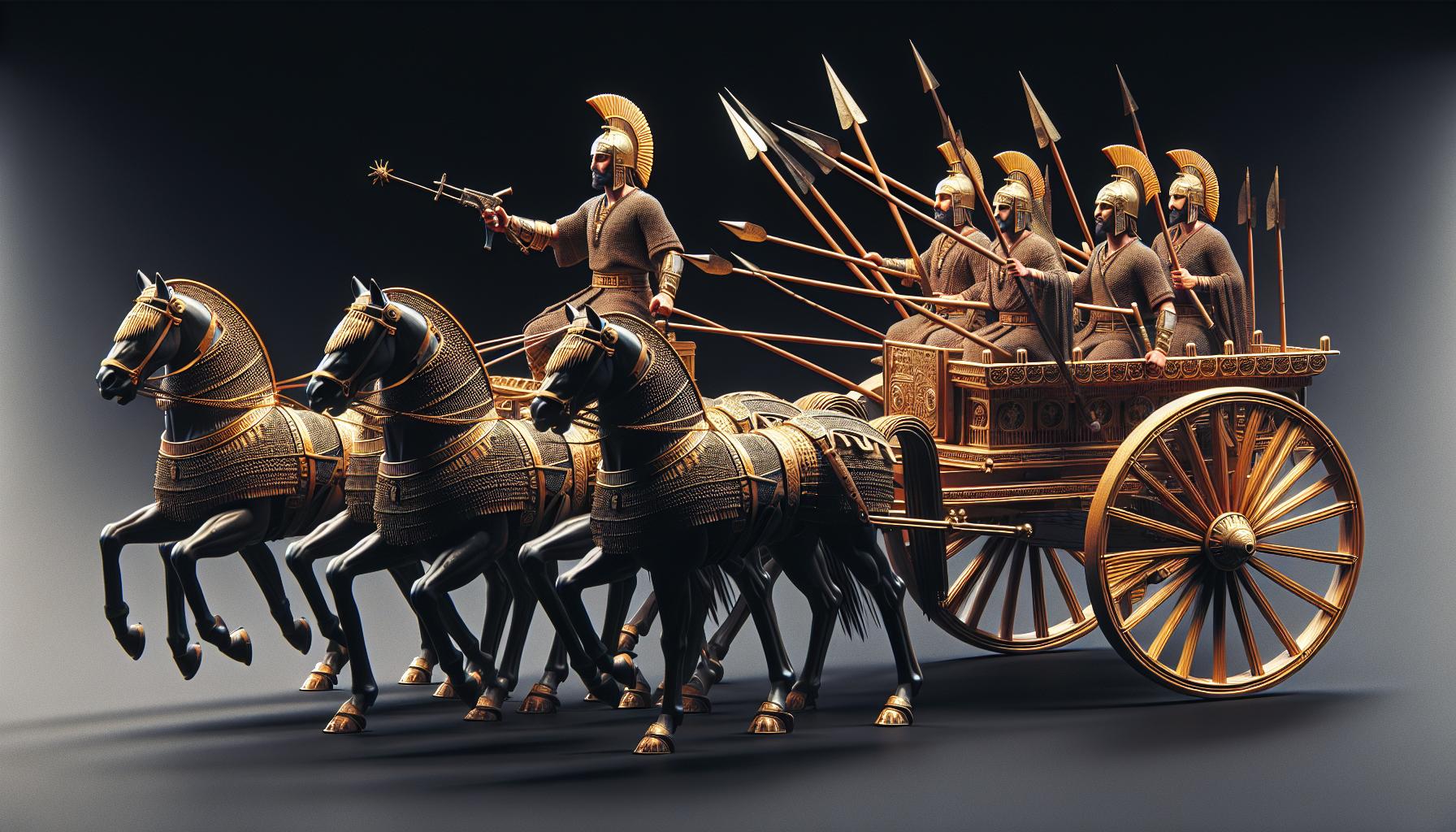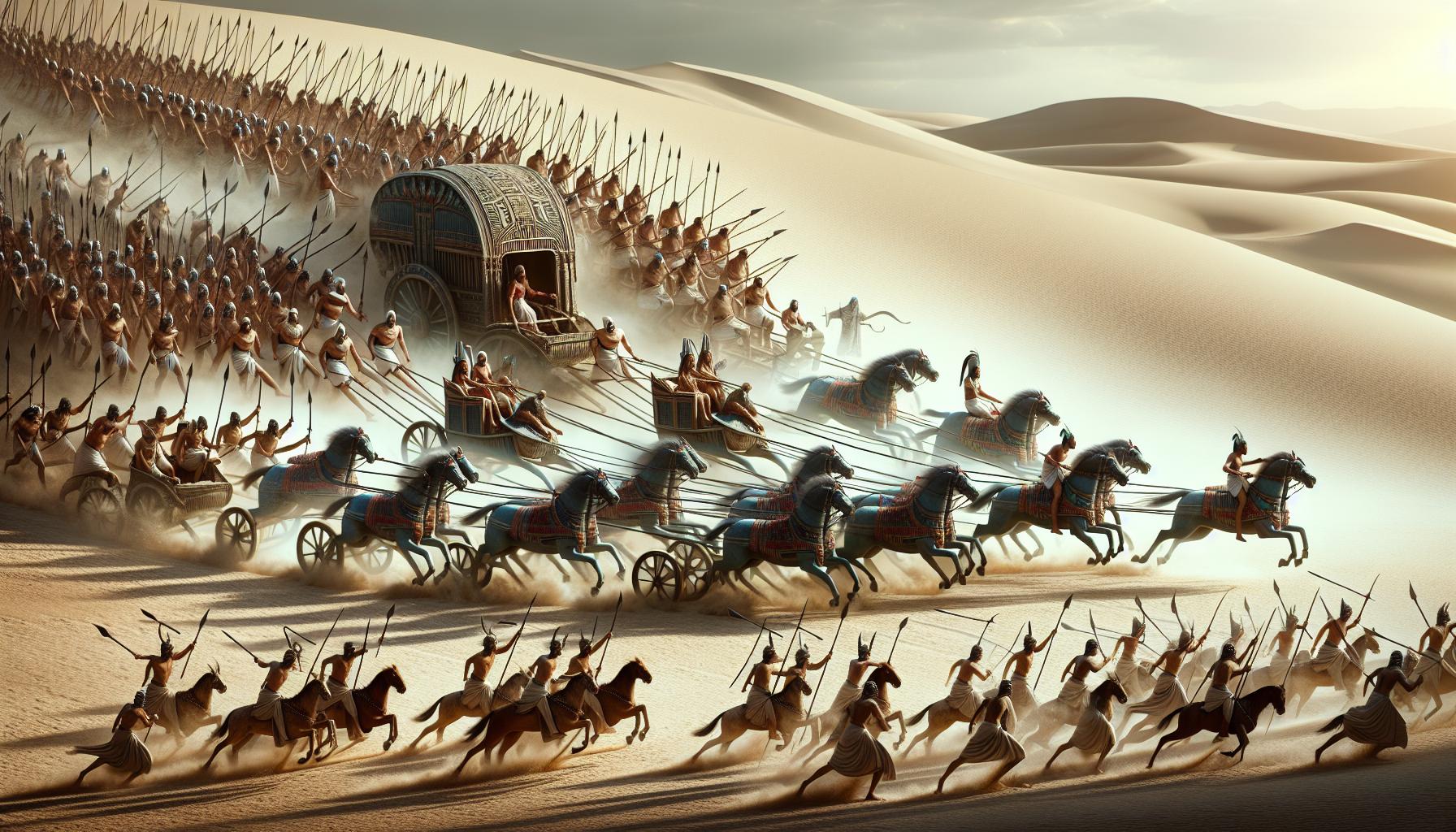Imagine a time when the rumble of wheels signaled the dawn of a new era in warfare. Ancient wheeled warfare revolutionized the battlefield, transforming the way battles were fought and won. From chariots to early war chariots, these wheeled vehicles changed the course of history.
You’ll delve into the fascinating world of ancient wheeled warfare, exploring how these innovative machines reshaped military strategies and tactics. Discover the pivotal role that chariots played in ancient civilizations’ military campaigns, from Egypt to Mesopotamia.
As we journey back in time, you’ll uncover the secrets of ancient wheeled warfare and gain a deeper understanding of how these early vehicles paved the way for modern military technology.
Overview of Ancient Wheeled Warfare
Ancient wheeled warfare revolutionized military tactics and strategies with the introduction of chariots in civilizations like Egypt and Mesopotamia. These wheeled vehicles played a crucial role in shaping early battlefield dynamics and influencing future military technologies.
Sumerian and Egyptian Chariots:
You’ve probably heard about the significant impact chariots had in ancient warfare. In Mesopotamia and Egypt, chariots were more than just vehicles; they were symbols of power and technological advancements, enabling military forces to move swiftly across battlefields.
Innovative Wheel Developments:
Mesopotamians were pioneers in wheel technology, creating some of the earliest wheeled vehicles. The invention of the wheel in this region not only transformed transportation but also laid the foundation for future engineering marvels.
Military Advantages:
Chariots gave ancient armies a strategic advantage in warfare, providing mobility, speed, and firepower. The incorporation of chariots into military campaigns changed the dynamics of battles, allowing for quick strikes and swift maneuvers.
Symbolism and Warfare:
Wheels in ancient warfare symbolized progress, power, and control. The symbolism associated with chariots went beyond their practical use, representing the authority and dominance of empires on the battlefield.
Impact on Civilizations:
The adoption of wheeled vehicles had a profound impact on ancient civilizations, facilitating trade, transportation, and conquest. The wheel’s role in shaping the economic and military landscape of these early societies cannot be understated.
Archaeological Significance:
Archaeological discoveries related to ancient wheeled warfare offer valuable insights into the technological advancements and military strategies of early civilizations. Studying these artifacts helps us understand the historical significance of wheeled vehicles in warfare.
Legacy of Ancient Warfare:
The legacy of ancient wheeled warfare persists in modern military tactics and technologies. The innovations and strategic use of chariots continue to influence military thinking and innovation to this day.
Ancient wheeled warfare, with its chariots and innovative technologies, was more than a military strategy—it was a pivotal moment in history that shaped the future of warfare and continues to inspire advancements in military technology.
Advancements in Military Technology

Continuing from the significant influence of ancient wheeled warfare on military strategies and tactics, let’s delve into the advancements in military technology facilitated by the innovation of wheeled vehicles.
Ancient Engineering Marvels
Ancient civilizations such as Mesopotamia and Egypt were at the forefront of harnessing the power of the wheel for warfare. The Sumerians, known for their technological advancements, played a pivotal role in the invention and development of the wheel. This Mesopotamian invention revolutionized transportation and warfare, paving the way for the creation of the earliest wheeled vehicles.
Military Strategy Evolution
The integration of wheeled vehicles, particularly chariots, into ancient warfare marked a significant advancement in military technology. The speed, mobility, and firepower provided by chariots equipped with spoked wheels enhanced the effectiveness of ancient armies in combat situations.
Symbolism and Strategic Significance
Beyond their practical use in battle, chariots held symbolic significance as representations of power and technological progress in warfare. Mesopotamian wheel symbolism extended beyond military applications, influencing various aspects of ancient societies.
Trade, Transportation, and Conquest
The adoption of wheeled vehicles, such as chariots, not only impacted military strategies but also played a crucial role in shaping ancient societies through trade, transportation, and conquest. The ease of mobility offered by chariots facilitated trade networks and expedited the transportation of goods and resources across vast territories.
Archaeological Discoveries
Archaeological excavations related to ancient wheeled warfare have unearthed valuable insights into the technological innovations of Mesopotamia and Egypt. Discoveries of ancient wheel materials, Mesopotamian wheel developments, and Egyptian adaptations provide a rich historical tapestry of the wheel’s impact on ancient civilizations.
Legacy and Modern Influence
The legacy of ancient wheeled warfare continues to influence modern military tactics and technologies. Understanding the advancements in military technology driven by the invention of the wheel offers valuable insights into the evolution of warfare and its enduring impact on civilization.
By exploring the advancements in military technology spurred by ancient wheeled warfare, you gain a deeper appreciation for the ingenuity and strategic prowess of ancient civilizations.
Tactics and Strategies
Ancient wheeled warfare revolutionized military tactics and strategies in civilizations like Mesopotamia and Egypt. Chariots, one of the earliest wheeled vehicles, played a crucial role in reshaping battlefield dynamics. Let’s delve into the strategic implementations of wheeled warfare:
Mobility Advantage
Chariots provided unmatched mobility on the battlefield. Their speed and agility allowed for swift maneuvers, making them ideal for quick strikes and flanking movements. Mesopotamian innovations such as spoked wheels enhanced maneuverability, giving armies a strategic edge.
Shock and Firepower
The chariot’s speed combined with its offensive capabilities created a devastating shock and firepower element in ancient battles. Equipped with archers or spear throwers, chariots could unleash barrages of projectiles while swiftly navigating the battlefield.
Psychological Impact
Beyond their tactical advantages, chariots had a significant psychological impact on enemies. The thunderous sound of chariot wheels rumbling across the battlefield instilled fear and uncertainty, disrupting enemy formations and morale.
Strategic Deployment
Ancient generals strategically deployed chariots to exploit their strengths. They were often used as a rapid response force to exploit gaps in enemy lines or to harass flanks. Chariot formations could swiftly reposition to counter enemy movements, demonstrating strategic flexibility.
Integration with Infantry
Chariots were often integrated with infantry forces to create combined arms tactics. The coordination between chariots and foot soldiers allowed for synergistic attacks, where chariots softened enemy positions before infantry engaged in close combat.
Legacy in Modern Tactics
The strategic principles of ancient wheeled warfare continue to influence modern military tactics. Concepts such as maneuver warfare, shock and awe tactics, and the integration of technology for battlefield dominance trace their roots back to the innovative strategies developed during ancient wheeled warfare eras.
Ancient wheeled warfare not only transformed military strategies but also left a lasting legacy on the evolution of warfare tactics across the ages.
Notable Battles and Empires
You’re about to explore some major battles and empires where ancient wheeled warfare played a pivotal role. These historical events highlight the strategic impact and military prowess of civilizations that utilized wheeled vehicles in combat.
1. Battle of Kadesh – Egyptian Empire
In the ancient Egyptian history of wheeled warfare, the Battle of Kadesh stands out as a significant conflict. This battle, fought between the Egyptians under Pharaoh Ramesses II and the Hittite Empire led by Muwatalli II, showcased the tactical advantage of chariots. The Egyptians relied heavily on their well-equipped chariot divisions to achieve mobility and strategic maneuverability on the battlefield. Despite the battle ending in a stalemate, it emphasized the importance of chariot technology in ancient warfare.
2. Assyrian Empire’s Military Campaigns
The Assyrian Empire’s military campaigns were characterized by their effective use of war chariots. Assyrian kings like Ashurbanipal and Tiglath-Pileser III employed chariots extensively to expand their empire and conquer new territories. These campaigns demonstrated the devastating impact of wheeled warfare, showcasing the Assyrians’ ability to dominate their enemies through swift maneuvering and coordinated chariot assaults.
3. Battle of Gaugamela – Alexander the Great
The Battle of Gaugamela, fought between Alexander the Great of Macedonia and Darius III of Persia, featured the innovative use of chariots by the Persian forces. Despite the Persian chariots not being as effective against Alexander’s phalanx formations, their presence on the battlefield highlighted the enduring influence of wheeled warfare tactics. Alexander’s victory at Gaugamela marked a turning point in ancient military history, showcasing the evolution of warfare strategies beyond traditional chariot-centric approaches.
4. Indus Valley Civilization and Chariots
The Indus Valley Civilization, known for its advanced urban centers and technological innovations, also made use of wheeled vehicles in various aspects of life. While the extent of wheeled warfare in the civilization remains debated, the presence of wheeled toys and artifacts suggests some form of chariot usage or transportation within the Indus Valley. This showcases the widespread adoption of wheeled technology across diverse ancient civilizations.
Legacy of Ancient Wheeled Warfare
In studying the legacy of ancient wheeled warfare, you can analyze the strategic significance and lasting impact of chariots in various historical contexts. The utilization of wheeled vehicles in military engagements left a profound mark on ancient civilizations and subsequent military tactics.
Strategic Advantages
- Ancient wheeled warfare, particularly chariots, provided unprecedented mobility, speed, and firepower to armies, revolutionizing military strategies.
- Chariots played a crucial role in battles and conquests, giving civilizations a distinct advantage in warfare due to their speed and maneuverability.
Notable Historical Events
- Battle of Kadesh (Egyptian Empire): In this pivotal battle, chariots were instrumental in warfare tactics, showcasing the military prowess of the Egyptian Empire.
- Assyrian Empire’s Military Campaigns: The Assyrians utilized chariots to expand their empire and dominate their opponents in battle.
- Battle of Gaugamela (Alexander the Great): Chariots were absent in this battle, emphasizing the shift towards other military technologies, marking a transition in ancient warfare tactics.
- Indus Valley Civilization: The potential use of chariots in this civilization demonstrates the widespread adoption and adaptation of wheeled vehicles in ancient societies.
- The legacy of ancient wheeled warfare continues to influence modern military strategies and technologies.
- The advancements in military technology driven by wheeled vehicles have had a lasting impact on military tactics and warfare evolution.
By examining these historical events and their impact, you gain valuable insights into how ancient wheeled warfare shaped military history and paved the way for advancements in military technology and tactics.
Conclusion
Ancient wheeled warfare revolutionized military tactics, providing unparalleled mobility and firepower in battles. The strategic significance of chariots in ancient civilizations like Egypt and Mesopotamia reshaped the course of history, influencing military advancements and conquests. From the Battle of Kadesh to the campaigns of the Assyrian Empire, wheeled vehicles played a pivotal role in shaping empires and determining the outcomes of conflicts. The enduring legacy of ancient wheeled warfare extends to modern military strategies and technologies, showcasing the lasting impact of these innovative military assets. As we reflect on the evolution of warfare tactics, it’s evident that the legacy of ancient wheeled warfare continues to shape the way we approach military engagements today.
Frequently Asked Questions
Q: What civilizations utilized chariots in ancient wheeled warfare?
A: Civilizations such as Egypt and Mesopotamia employed chariots for military purposes, utilizing their mobility and firepower.
Q: How did wheeled vehicles impact military strategies in ancient times?
A: Wheeled vehicles revolutionized military strategies by providing speed, mobility, and enhanced firepower on the battlefield.
Q: Which notable battles showcased the significance of wheeled warfare?
A: Battles like the Battle of Kadesh and the campaigns of the Assyrian Empire highlighted the pivotal role of wheeled warfare.
Q: How does ancient wheeled warfare influence modern military tactics?
A: The legacy of ancient wheeled warfare continues to shape modern military tactics and technologies, emphasizing strategic advantages.
Q: What lasting impact do chariots have on the evolution of warfare tactics?
A: Chariots demonstrated strategic advantages in battles and conquests, leaving a lasting impact on military history and warfare evolution.
